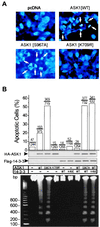Suppression of apoptosis signal-regulating kinase 1-induced cell death by 14-3-3 proteins
- PMID: 10411906
- PMCID: PMC17547
- DOI: 10.1073/pnas.96.15.8511
Suppression of apoptosis signal-regulating kinase 1-induced cell death by 14-3-3 proteins
Abstract
Apoptosis signal-regulating kinase 1 (ASK1) is a pivotal component of a signaling pathway induced by many death stimuli, including tumor necrosis factor alpha, Fas, and the anticancer drugs cisplatin and paclitaxel. Here we report that ASK1 proapoptotic activity is antagonized by association with 14-3-3 proteins. We found that ASK1 specifically bound 14-3-3 proteins via a site involving Ser-967 of ASK1. Interestingly, overexpression of 14-3-3 in HeLa cells blocked ASK1-induced apoptosis whereas disruption of the ASK1/14-3-3 interaction dramatically accelerated ASK1-induced cell death. Targeting of ASK1 by a 14-3-3-mediated survival pathway may provide a novel mechanism for the suppression of apoptosis.
Figures




Similar articles
-
Reciprocal negative regulation of PDK1 and ASK1 signaling by direct interaction and phosphorylation.J Biol Chem. 2010 Jan 22;285(4):2397-414. doi: 10.1074/jbc.M109.064295. Epub 2009 Nov 17. J Biol Chem. 2010. PMID: 19920149 Free PMC article.
-
Interaction of apoptosis signal-regulating kinase 1 with isoforms of 14-3-3 proteins.Exp Cell Res. 2004 Apr 1;294(2):581-91. doi: 10.1016/j.yexcr.2003.12.009. Exp Cell Res. 2004. PMID: 15023544
-
Negative control of apoptosis signal-regulating kinase 1 through phosphorylation of Ser-1034.Oncogene. 2004 Jun 24;23(29):5099-104. doi: 10.1038/sj.onc.1207668. Oncogene. 2004. PMID: 15094778
-
Physiological roles of ASK1-mediated signal transduction in oxidative stress- and endoplasmic reticulum stress-induced apoptosis: advanced findings from ASK1 knockout mice.Antioxid Redox Signal. 2002 Jun;4(3):415-25. doi: 10.1089/15230860260196218. Antioxid Redox Signal. 2002. PMID: 12215209 Review.
-
Survival-promoting functions of 14-3-3 proteins.Biochem Soc Trans. 2002 Aug;30(4):360-5. doi: 10.1042/bst0300360. Biochem Soc Trans. 2002. PMID: 12196095 Review.
Cited by
-
AIP1 mediates TNF-alpha-induced ASK1 activation by facilitating dissociation of ASK1 from its inhibitor 14-3-3.J Clin Invest. 2003 Jun;111(12):1933-43. doi: 10.1172/JCI17790. J Clin Invest. 2003. PMID: 12813029 Free PMC article.
-
Apoptosis signal-regulating kinase 1 in amyloid beta peptide-induced cerebral endothelial cell apoptosis.J Neurosci. 2007 May 23;27(21):5719-29. doi: 10.1523/JNEUROSCI.1874-06.2007. J Neurosci. 2007. PMID: 17522316 Free PMC article.
-
The roles of ASK family proteins in stress responses and diseases.Cell Commun Signal. 2009 Apr 24;7:9. doi: 10.1186/1478-811X-7-9. Cell Commun Signal. 2009. PMID: 19389260 Free PMC article.
-
A Novel ASK Inhibitor AGI-1067 Inhibits TLR-4-Mediated Activation of ASK1 by Preventing Dissociation of Thioredoxin from ASK1.Cardiovasc Pharm Open Access. 2015 Apr;4(1):132. doi: 10.4172/2329-6607.1000132. Epub 2015 Feb 26. Cardiovasc Pharm Open Access. 2015. PMID: 28435845 Free PMC article.
-
The ADP-stimulated NADPH oxidase activates the ASK-1/MKK4/JNK pathway in alveolar macrophages.Free Radic Res. 2006 Aug;40(8):865-74. doi: 10.1080/10715760600758514. Free Radic Res. 2006. PMID: 17015265 Free PMC article.
References
-
- Jacobson M D, Weil M, Raff M C. Cell. 1997;88:347–354. - PubMed
-
- Rudin C M, Thompson C B. Annu Rev Med. 1997;48:267–281. - PubMed
-
- Ellis R E, Yuan J Y, Horvitz H R. Annu Rev Cell Biol. 1991;7:663–698. - PubMed
-
- Cryns V, Yuan J. Genes Dev. 1998;12:1551–1570. - PubMed
-
- Ashkenazi A, Dixit V M. Science. 1998;281:1305–1308. - PubMed
Publication types
MeSH terms
Substances
Grants and funding
LinkOut - more resources
Full Text Sources
Other Literature Sources
Molecular Biology Databases
Research Materials
Miscellaneous

